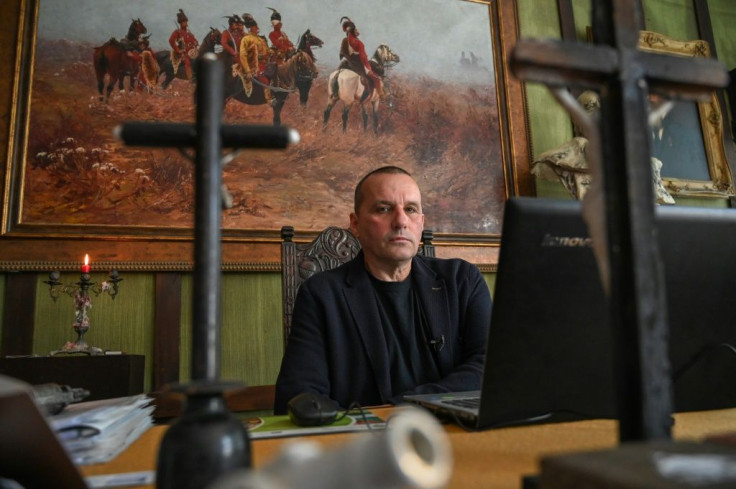Hungary Haunted By Post-WWI 'Dismemberment', 100 Years On
For Hungary's nationalist leader Viktor Orban it marks the country's darkest day: "June 4, 1920," a date carved into a triangular column marking the spot where the Hungarian, Romanian, and Serbian borders meet.
It was on that day, soon after World War I, that a treaty was signed in the Trianon palace in Versailles, France, defining Hungary's new shrunken frontiers after the dissolution of the Austro-Hungarian empire.
"Flags here will be at half-mast on June 4," said Robert Molnar, mayor of Kubekhaza, a village beside the tri-border, ahead of the centenary Thursday.
"The Trianon borders split up villages and families," Molnar told AFP, pointing at church towers across the fields -- each in a different country.
Hungary, as part of the defeated Austro-Hungarian empire, was forced to sign away two-thirds of its territory, and half of its multi-ethnic population.
At a stroke, more than three million ethnic Hungarians -- or Magyars -- a third of the total, as well as key economic resources and several historic cities became part of neighbouring states.
"The great powers led by France unjustly punished Hungary, no matter the cost," Csaba Pal Szabo, director of a state-financed Trianon Museum, told AFP at the museum's archive in the city of Szeged near the Serbian border.
"We were betrayed by the West."
Szabo objects to what he says were unfairly drawn borders "not reflecting ethnic populations on the ground".
Among the historical maps and memorabilia on display are 1920s propaganda material proclaiming "No! No! Never!" -- and calling for territorial revision.
Hungary's interwar leader Miklos Horthy later allied with Nazi Germany, partly in a bid to reclaim lost lands. But another treaty in 1947 confirmed the borders set out at Trianon.
During the subsequent four decades of communist rule, any mention of Trianon was taboo in case it riled fellow socialist states.
This was despite widespread discrimination endured by Magyar minorities -- especially under Romanian dictator Nicolae Ceausescu.
EU membership for Hungary and most of its neighbours has since 2004 brought more cross-border freedom of movement. Even so, moving on from Trianon has proved difficult.

On coming to power in 2010, Orban adopted an assertive "national policy" aimed at uniting Hungarians after what he calls the "dismemberment".
Orban, 57, swiftly declared June 4 a "Day of National Cohesion", and has since sent lavish financial aid to schools, cultural and religious groups in the diaspora.
He also granted dual citizenship and voting rights to more than a million non-residents -- many of whom have voted for his Fidesz party in Hungarian elections.
A "National Cohesion" monument will be unveiled soon in Budapest bearing the Hungarian-language names of villages, towns and cities in pre-WWI Greater Hungary.
After historians spotted that many of the localities listed on it were never populated by ethnic Hungarians, a government official denied the edifice expressed a desire to turn the clock back.
Orban's fondness for Greater Hungary nostalgia encourages an idealised picture of relations between Hungarians and other ethnic groups before WW1, according to analysts, and appeals to ultra-nationalistic voters in particular.
In recent speeches, he has made what appear to be more conciliatory calls for regional cooperation to "build Central Europe".
But Orban's critics worry that his policies have frayed relations with Hungary's neighbours -- and could harm the prospects of the diaspora communities.
In Romania, Hungarian aid to Transylvania is seen as meddling. Orban is accused by nationalists there of fomenting demands for autonomy in the mostly ethnic-Hungarian Szeklerland region.
Many new dual citizens in non-EU members Serbia and Ukraine meanwhile have used their Hungarian passports to emigrate to Hungary or richer western Europe rather than stay home.
The diaspora population in Hungary's neighbours has dwindled to under two million, mainly due to emigration and assimilation over the past century.
But many Hungarians still have relatives or roots there, ensuring that Trianon remains an emotive issue.
Budapest's liberal mayor has called for a minute of silence across the city Thursday, a sign that the trauma cuts across party lines.
"It's unclear how Hungary can ever get over it," historian Gabor Egry told AFP.
"Official commemorations emphasise only the suffering, not the nuances or diversity of the minority experiences in the different countries, or how things have changed."
Balazs Erlauer, a 34-year-old Magyar from Serbia's multi-ethnic Vojvodina region who moved to Hungary when his family fled the 1990s Yugoslav wars, said he "would happily forget about discussing Trianon" if he was allowed to do so.
What bothered him, he told AFP, was not "lines on a map as much as nationalistic aggression".
© Copyright AFP 2024. All rights reserved.





















